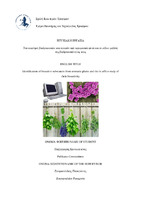| dc.contributor.advisor | Zoumpoulakis, Panagiotis | |
| dc.contributor.author | Παλληκαράς, Κωνσταντίνος | |
| dc.date.accessioned | 2023-10-26T12:52:56Z | |
| dc.date.available | 2023-10-26T12:52:56Z | |
| dc.date.issued | 2023-09-21 | |
| dc.identifier.uri | https://polynoe.lib.uniwa.gr/xmlui/handle/11400/5501 | |
| dc.identifier.uri | http://dx.doi.org/10.26265/polynoe-5338 | |
| dc.description.abstract | Η παρούσα εργασία έχει θέμα ‘Ταυτοποίηση βιοδραστικών συστατικών από αρωματικά φυτά και in sillico μελέτη της βιοδραστικότητας τους’, δηλαδή διερεύνηση, μελέτη και εξέταση των φυσικοχημικών ιδιοτήτων που διαθέτουν τα επιλεγμένα αρωματικά φυτά και συσχέτιση της δομής των ενώσεων με συγκεκριμένες ιδιότητες με έμφαση στις αντιμικροβιακές ιδιότητες για τροφιμογενή παθογόνα. Σκοπός της συσχέτισης είναι να παρατηρηθεί σχέση ανάμεσα στη δομή των ενώσεων με τις ιδιότητες τους και μελέτη των αποτελεσμάτων για την πρόβλεψη των βέλτιστων παραμέτρων. Η γνώση αυτή μπορεί να χρησιμοποιηθεί ως εργαλείο στην επιστήμη και τεχνολογία τροφίμων για την αντιμετώπιση κινδύνων μικροβιακής προέλευσης στα τρόφιμα. Συγκεκριμένα στην παρούσα εργασία πραγματοποιήθηκε συλλογή των αρχείων SMILES των χημικών ενώσεων που περιλαμβάνονται σε κάθε αρωματικό φυτό και ακολούθησε πρόβλεψη των φυσικοχημικών τους ιδιοτήτων. Μελετήθηκαν οι ενώσεις για την δραστικότητα τους σε μικροβιακούς στόχους από επιστημονικά άρθρα και έγινε η συσχέτιση με τις ιδιότητες σε μορφή γραφικών παραστάσεων. Τα αποτελέσματα δεν έδειξαν καθαρή συσχέτιση. Τέλος, η in sillico μελέτη ολοκληρώθηκε με τη διεξαγωγή πειραμάτων μοριακής πρόσδεσης, χρησιμοποιώντας το ένζυμο τοποϊσομεράση IV της E.Coli, καθώς εμπλέκεται με τη διάνοιξη του γενετικού υλικού DNA. Τα πειράματα μοριακής πρόσδεσης κατέδειξαν ότι το δεντρολίβανο παρουσιάζει τις μεγαλύτερες δυνατότητες και πιθανότητες να προσδένεται με το ένζυμο με βάση σε πειραματικές τιμές που εξάχθηκαν από την μελέτη. | el |
| dc.format.extent | 57 | el |
| dc.language.iso | el | el |
| dc.publisher | Πανεπιστήμιο Δυτικής Αττικής | el |
| dc.rights | Αναφορά Δημιουργού - Μη Εμπορική Χρήση - Παρόμοια Διανομή 4.0 Διεθνές | * |
| dc.rights | Attribution-NonCommercial-NoDerivatives 4.0 Διεθνές | * |
| dc.rights.uri | http://creativecommons.org/licenses/by-nc-nd/4.0/ | * |
| dc.subject | Βοτανικά εκχυλίσματα | el |
| dc.subject | Βιοδραστικές ενώσεις | el |
| dc.subject | Αντιμικροβιακή δράση | el |
| dc.subject | Μοριακή πρόσδεση | el |
| dc.subject | Αρωματικά φυτά | el |
| dc.subject | Φαρμακευτικά φυτά | el |
| dc.title | Ταυτοποίηση βιοδραστικών συστατικών από αρωματικά φυτά και in sillico μελέτη της βιοδραστικότητας τους | el |
| dc.title.alternative | Identification of bioactive substances from aromatic plants and the in sillico study of their bioactivity | el |
| dc.type | Πτυχιακή εργασία | el |
| dc.contributor.committee | Κρίτση, Ευτυχία | |
| dc.contributor.committee | Σινάνογλου, Βασιλεία | |
| dc.contributor.faculty | Σχολή Επιστημών Τροφίμων | el |
| dc.contributor.department | Τμήμα Επιστήμης και Τεχνολογίας Τροφίμων | el |
| dc.description.abstracttranslated | This study is entitled "Identification of bioactive substances from aromatic plants and the in sillico study of their bioactivity", namely investigation, study and examination of selected aromatic plants physicochemical properties and correlation of their structure with specific properties, emphasizing on antimicrobial properties against food-borne pathogens. The goal of this correlation is to observe the relationship between the chemical structure of the compounds with their properties and to predict the optimal parameters. The use of this information can be used as a tool in food science and food science and technology for fighting food related microorganisms. Specifically, in the present study SMILES files were collected for the compounds of aromatic plants and their physiochemical properties were predicted. Scientific articles were used in order to study the bioactivity of the examined compounds in microbial targets and graphs were created to understand if there were any correlation. The result showed no clear correlation. Finally, the in sillico study was carried out by applying molecular docking experiments, using the enzyme topoisomerase IV of E. Coli, as that it is involved in the unraveling of the DNA helix. The molecular docking experiments showed that rosemary shows the biggest potential and possibilities to attach to the enzyme based on the experimental values extracted from the study. | el |



